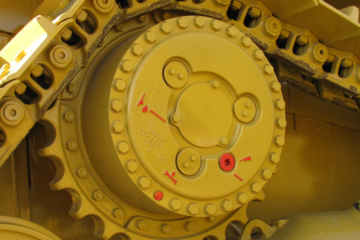Undercarriage Inspections are not as common as Oil Sampling yet, but they are just as important. Every activity has a cost and a potential value added. Take and Oil Sample on an engine. Take all the oil samples over the life of the engine and full life can be achieved instead of a catastrophic failure with associated costs for this event.

Inspections on undercarriage are carried out generally at intervals of 500 hours on dozers, and about 2000 hours on excavators. If the Undercarriage is anticipated to live a full life of 6,000 hours, this would mean 12 inspections during its life. Labor should cost approximately $150 per hour, and the physical inspection should take no more than 25 to 30 minutes, with the remaining 30 minutes of the hour spent interpreting, analyzing, comparing with historical results and formulating any recommended corrective actions. That gives an approximate cost of $150.00 per inspection.
Over the life of the undercarriage of 6,000 hours, the cost of inspecting would be 150 X 12 = $1,800
The cost of undercarriage on say a D10R for both sides would be approximately $150,000, therefore the cost to monitor the undercarriage over its full life, or the insurance policy is $1,800 or 1.2%.
If for example, inspections are not completed on the undercarriage, generally the life that can be achieved would lie in the range of 50 to 65% of full undercarriage life. Each machine instance would be different depending on the limiting factors present, whether it be seal life causing dry joints, bush turns missed etc. However, the value to be gained by achieving more than 65% of full undercarriage life, is potentially 35% of life, or value equaling $52,500
In the instance where the undercarriage is inspected and monitored consistently, leading to bush turns being done, and other interventions required to achieve as close to full life as possible, then on average, life achieved would be closer to 95% of full life. This means a potential loss of value of 5% equaling $7,500. (Remember that components can be taken to 120% life on destruction)
Therefore, the difference between inspecting or not inspecting is easy to see
| Description | No Inspections | Inspecting every 500 Hours | Difference |
| Life Foregone | $52,500 | $ 7,500 | $45,000 |
| Cost of inspection over life | $ 1,800 | ($1,800) | |
| Total Cost | $52,500 | $ 9,300 | $43,200 |
In this example, the potential gain by inspecting regularly is a minimum of $43,200 and this assumes a least-case scenario. The gain might be even greater.
Insurance Policy – Warranty Claims or hidden gains
A little more difficult to put into numbers the value of the insurance policy inherent through inspections. A good example is the discussion you might have if trying to claim warranty on a faulty component under the conditions where there have been 1.) No inspections or, 2)Undercarriage components having been inspected regularly. Warranty claims are common but require the support of data rather than hearsay.
This proves the value of carrying out a program of Undercarriage Inspections and TrackTreads has the system and tools to enable you to meet these requirements.



0 Comments